Intensity Modulated Photothermal Measurements of NO2 with a Compact Fiber-Coupled Fabry–Pérot Interferometer
Abstract
1. Introduction
2. Materials and Methods
2.1. Photothermal Interferometry
2.2. Experimental Setup
3. Results
3.1. Influence of Flow Rate on Sensor Noise
3.2. Selection of the Optimal Modulation Frequency
3.3. Limit of Detection and Long Term Stability
3.4. Response Time
4. Discussion and Conclusions
Author Contributions
Funding
Acknowledgments
Conflicts of Interest
Abbreviations
| PTI | photothermal interferometry |
| PAS | photoacoustic spectroscopy |
| QEPAS | quartz-enhanced photoacoustic spectroscopy |
| ksps | kilosamples per second |
| NNEA | noise normalized equivalent absorption |
Appendix A. Drift of the Laser Power

References
- World Health Organisation. Air Quality Guidelines for Particulate Matter, Ozone, Nitrogen Dioxide and Sulfur Dioxide—Global Update 2005; WHO Press: Geneva, Switzerland, 2006. [Google Scholar]
- Wild, R.J.; Dubé, W.P.; Aikin, K.C.; Eilerman, S.J.; Neuman, J.A.; Peischl, J.; Ryerson, T.B.; Brown, S.S. On-road measurements of vehicle NO2/NOx emission ratios in Denver, Colorado, USA. Atmos. Environ. 2017, 148, 182–189. [Google Scholar] [CrossRef]
- Hagemann, R.; Corsmeier, U.; Kottmeier, C.; Rinke, R.; Wieser, A.; Vogel, B. Spatial variability of particle number concentrations and NOx in the Karlsruhe (Germany) area obtained with the mobile laboratory ‘AERO-TRAM’. Atmos. Environ. 2014, 94, 341–352. [Google Scholar] [CrossRef]
- Mead, M.I.; Popoola, O.A.M.; Stewart, G.B.; Landshoff, P.; Calleja, M.; Hayes, M.; Baldovi, J.J.; McLeod, M.W.; Hodgson, T.F.; Dicks, J.; et al. The use of electrochemical sensors for monitoring urban air quality in low-cost, high-density networks. Atmos. Environ. 2013, 70, 186–203. [Google Scholar] [CrossRef]
- European Parliament, Council of the European Union. Directive 2008/50/EC of the European Parliament and of the Council of 21 May 2008 on ambient air quality and cleaner air for Europe. Off. J. Eur. Union 2008, L 152, 1–44. [Google Scholar]
- Castell, N.; Dauge, F.R.; Schneider, P.; Vogt, M.; Lerner, U.; Fishbain, B.; Broday, D.; Bartonova, A. Can commercial low-cost sensor platforms contribute to air quality monitoring and exposure estimates? Environ. Int. 2017, 99, 293–302. [Google Scholar] [CrossRef] [PubMed]
- Miklós, A.; Hess, P.; Bozóki, Z. Application of acoustic resonators in photoacoustic trace gas analysis and metrology. Rev. Sci. Instrum. 2001, 72, 1937–1955. [Google Scholar] [CrossRef]
- Kalkman, J.; van Kesteren, H. Relaxation effects and high sensitivity photoacoustic detection of NO2 with a blue laser diode. Appl. Phys. B 2008, 90, 197–200. [Google Scholar] [CrossRef]
- Yin, X.; Dong, L.; Wu, H.; Zheng, H.; Ma, W.; Zhang, L.; Yin, W.; Jia, S.; Tittel, F.K. Sub-ppb nitrogen dioxide detection with a large linear dynamic range by use of a differential photoacoustic cell and a 3.5 W blue multimode diode laser. Sens. Actuators B Chem. 2017, 247, 329–335. [Google Scholar] [CrossRef]
- Rück, T.; Bierl, R.; Matysik, F.M. Low-cost photoacoustic NO2 trace gas monitoring at the pptV-level. Sens. Actuators A Phys. 2017, 263, 501–509. [Google Scholar] [CrossRef]
- Kosterev, A.A.; Bakhirkin, Y.A.; Curl, R.F.; Tittel, F.K. Quartz-enhanced photoacoustic spectroscopy. Opt. Lett. 2002, 27, 1902–1904. [Google Scholar] [CrossRef]
- Yi, H.; Liu, K.; Chen, W.; Tan, T.; Wang, L.; Gao, X. Application of a broadband blue laser diode to trace NO2 detection using off-beam quartz-enhanced photoacoustic spectroscopy. Opt. Lett. 2011, 36, 481–483. [Google Scholar] [CrossRef] [PubMed]
- Zheng, H.; Dong, L.; Yin, X.; Liu, X.; Wu, H.; Zhang, L.; Ma, W.; Yin, W.; Jia, S. Ppb-level QEPAS NO2 sensor by use of electrical modulation cancellation method with a high power blue LED. Sens. Actuators B Chem. 2015, 208, 173–179. [Google Scholar] [CrossRef]
- Rück, T.; Bierl, R.; Matysik, F.M. NO2 trace gas monitoring in air using off-beam quartz enhanced photoacoustic spectroscopy (QEPAS) and interference studies towards CO2, H2O and acoustic noise. Sens. Actuators B Chem. 2018, 255, 2462–2471. [Google Scholar] [CrossRef]
- Campillo, A.J.; Petuchowski, S.J.; Davis, C.C.; Lin, H.B. Fabry-perot photothermal trace detection. Appl. Phys. Lett. 1982, 41, 327–329. [Google Scholar] [CrossRef]
- Waclawek, J.P.; Bauer, V.C.; Moser, H.; Lendl, B. 2f-wavelength modulation Fabry-Perot photothermal interferometry. Opt. Express 2016, 24, 28958–28967. [Google Scholar] [CrossRef]
- Waclawek, J.P.; Kristament, C.; Moser, H.; Lendl, B. Balanced-detection interferometric cavity-assisted photothermal spectroscopy. Opt. Express 2019, 27, 12183–12195. [Google Scholar] [CrossRef]
- Yang, F.; Jin, W.; Lin, Y.; Wang, C.; Lut, H.; Tan, Y. Hollow-core microstructured optical fiber gas sensors. J. Lightwave Technol. 2016, 35, 3413–3424. [Google Scholar] [CrossRef]
- Krzempek, K. A Review of Photothermal Detection Techniques for Gas Sensing Applications. Appl. Sci. 2019, 9, 2826. [Google Scholar] [CrossRef]
- Wynne, R.M.; Barabadi, B.; Creedon, K.J.; Ortega, A. Sub-Minute Response Time of a Hollow-Core Photonic Bandgap Fiber Gas Sensor. J. Lightwave Technol. 2009, 27, 1590–1596. [Google Scholar] [CrossRef]
- Hoo, Y.L.; Liu, S.; Ho, H.L.; Jin, W. Fast response microstructured optical fiber methane sensor with multiple side-openings. IEEE Photonics Technol. Lett. 2010, 22, 296–298. [Google Scholar] [CrossRef]
- Davis, C.C.; Petuchowski, S.J. Phase fluctuation optical heterodyne spectroscopy of gases. Appl. Opt. 1981, 20, 2539–2554. [Google Scholar] [CrossRef] [PubMed]
- Hecht, E. Optics, Global Edition, 5th ed.; Pearson: London, UK, 2017. [Google Scholar]
- Preisser, S.; Rohringer, W.; Liu, M.; Kollmann, C.; Zotter, S.; Fischer, B.; Drexler, W. All-optical highly sensitive akinetic sensor for ultrasound detection and photoacoustic imaging. Biomed. Opt. Express 2016, 7, 4171–4186. [Google Scholar] [CrossRef] [PubMed]
- Fischer, B.; Wintner, E. Sound Recording by Laser Interferometry. In Proceedings of the Conference on Lasers and Electro-Optics/International Quantum Electronics Conference, Baltimore, MD, USA, 31 May–5 June 2009; OSA: Washington, DC, USA, 2009; p. JWA64. [Google Scholar] [CrossRef]
- Roehl, C.M.; Orlando, J.J.; Tyndall, G.S.; Shetter, R.E.; Vazquez, G.J.; Cantrell, C.A.; Calvert, J.G. Temperature Dependence of the Quantum Yields for the Photolysis of NO2 Near the Dissociation Limit. J. Phys. Chem. 1994, 98, 7837–7843. [Google Scholar] [CrossRef]
- Breitegger, P.; Bergmann, A. A Precise Gas Dilutor Based on Binary Weighted Critical Flows to Create NO2 Concentrations. Proceedings 2018, 2, 998. [Google Scholar] [CrossRef]
- Mil-STD-810H: Department of Defense Test Method Standard for Environmental Engineering Considerations and Laboratory Tests; US Department of Defense (DoD): Washington, DC, USA, 2019.
- Herault, J.; Pétrélis, F.; Fauve, S. 1/fα Low Frequency Fluctuations in Turbulent Flows. J. Stat. Phys. 2015, 161, 1379–1389. [Google Scholar] [CrossRef]
- Vandaele, A.; Hermans, C.; Simon, P.; Carleer, M.; Colin, R.; Fally, S.; Mérienne, M.; Jenouvrier, A.; Coquart, B. Measurements of the NO2 absorption cross-section from 42,000 cm−1 to 10,000 cm−1 (238–1000 nm) at 220 K and 294 K. J. Quant. Spectrosc. Radiat. Transf. 1998, 59, 171–184. [Google Scholar] [CrossRef]
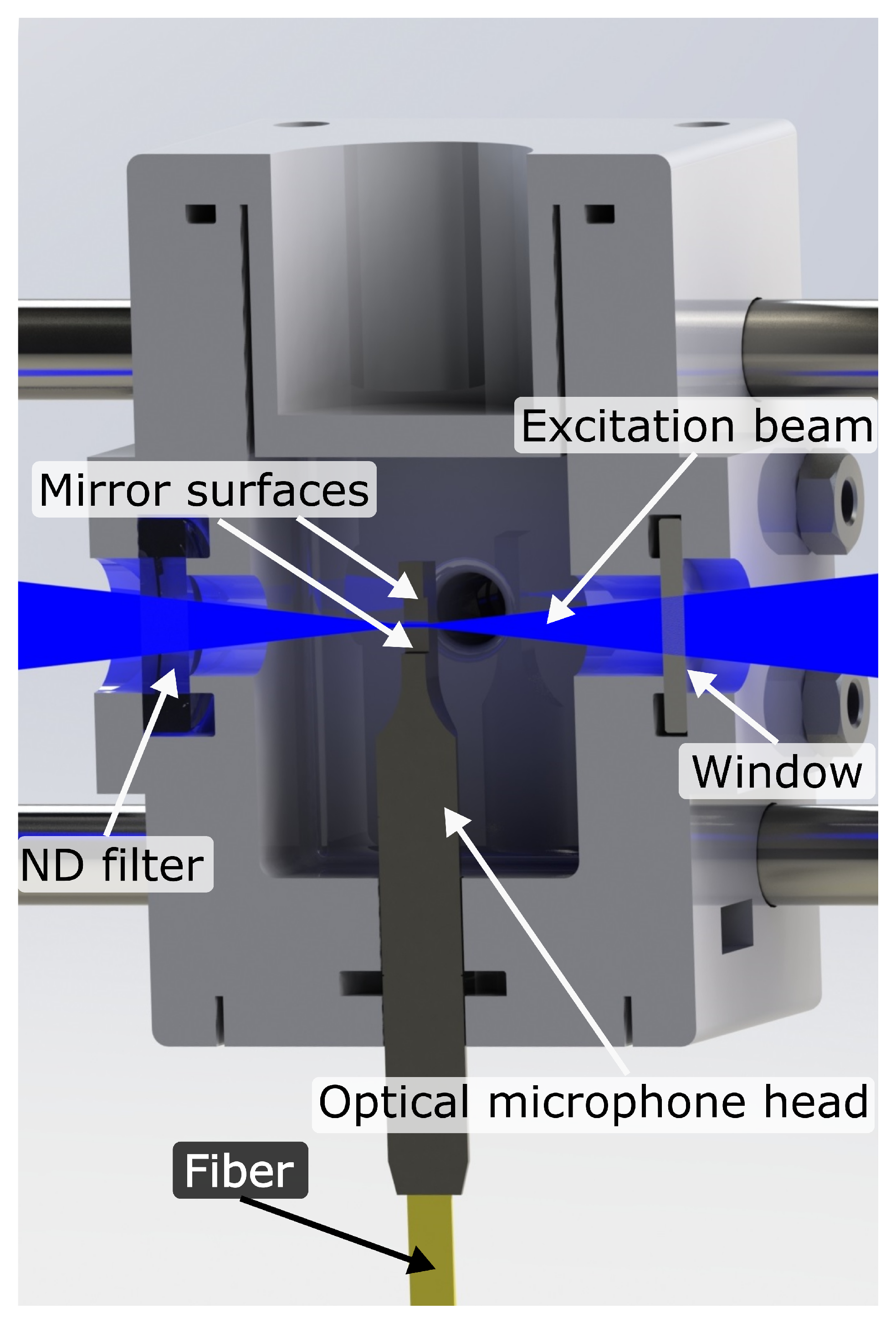

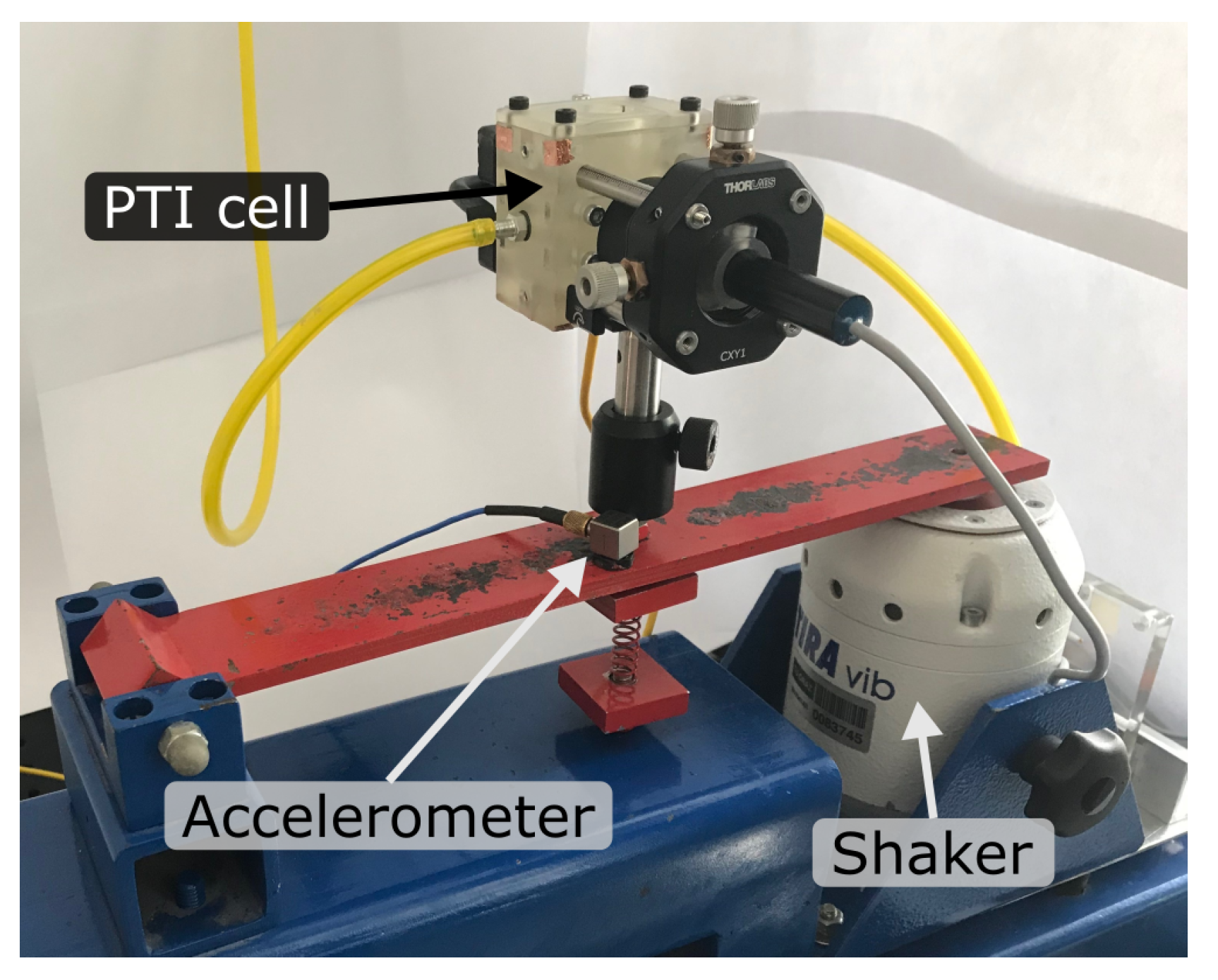
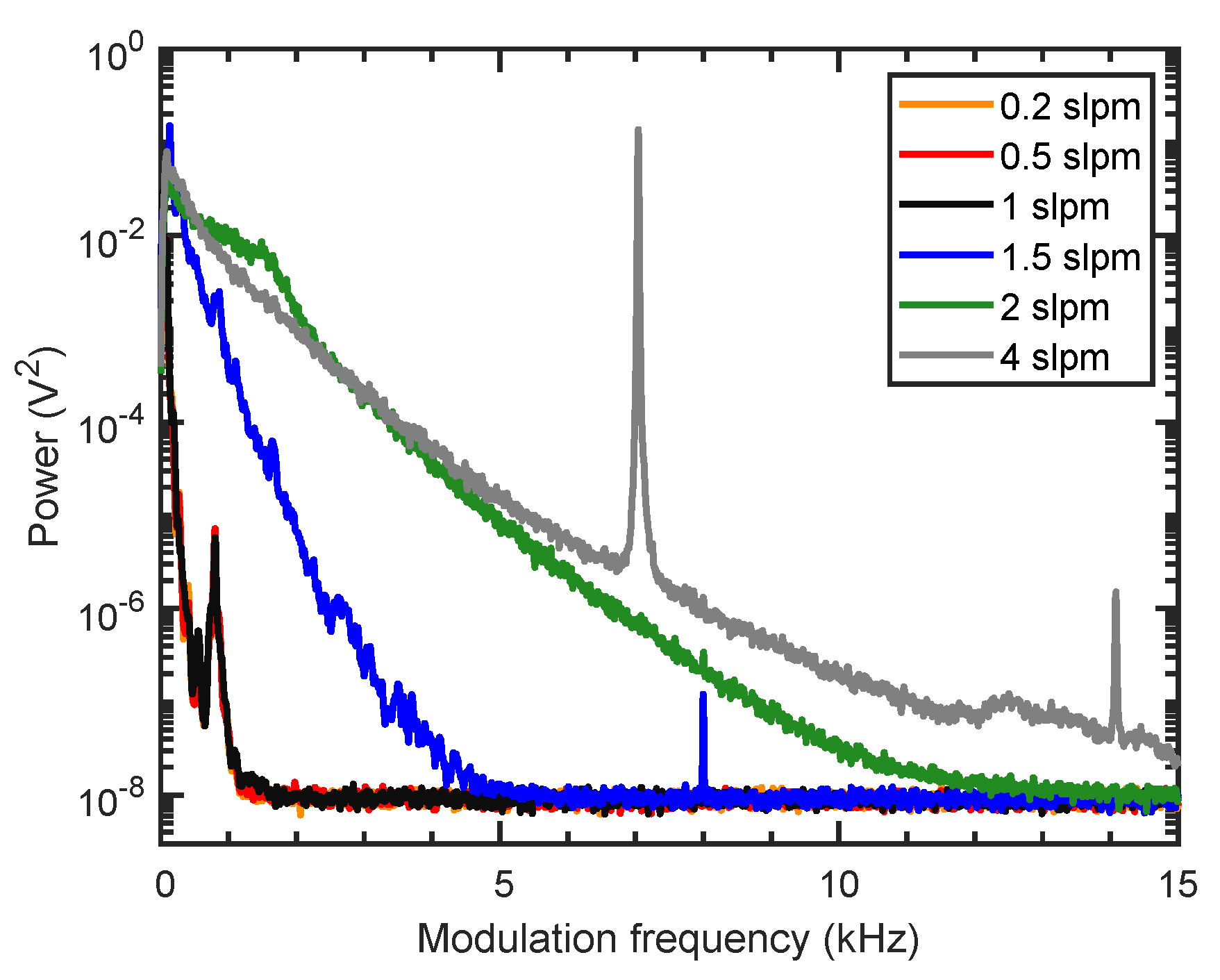
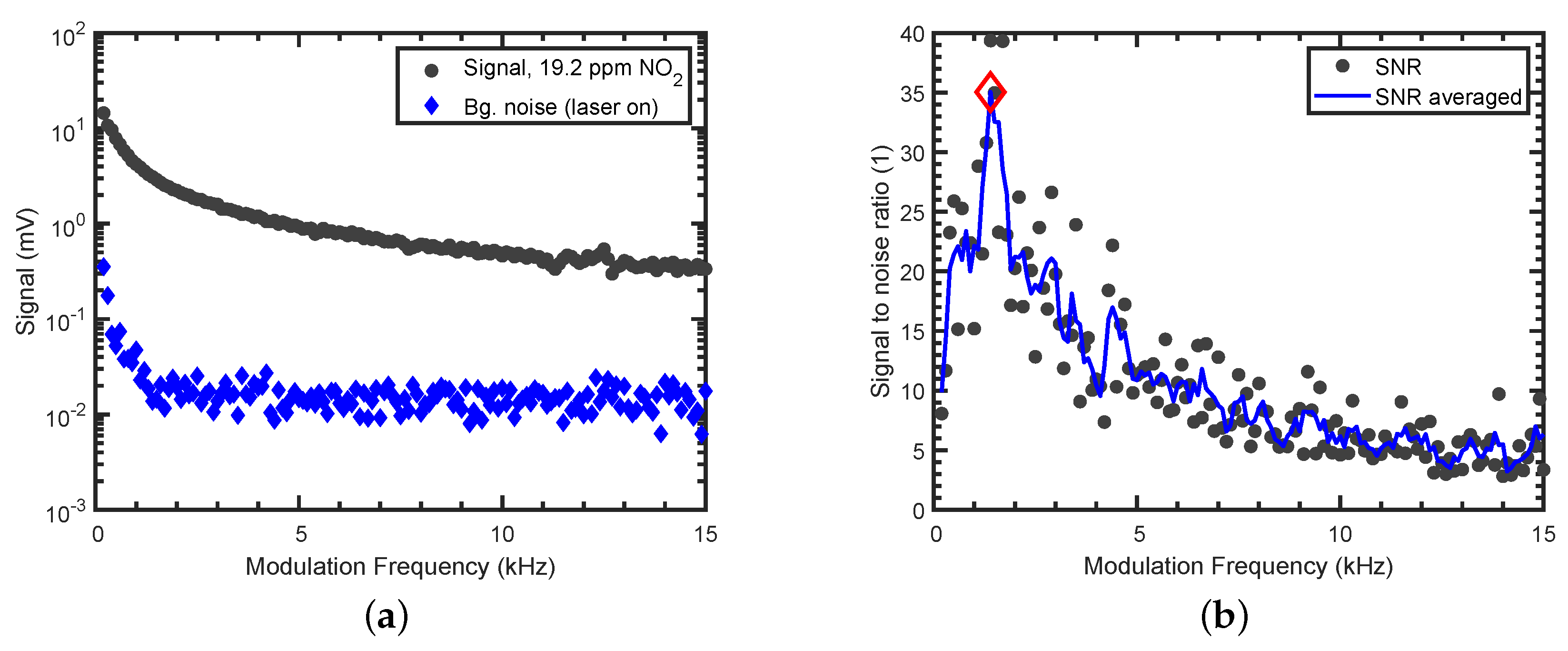
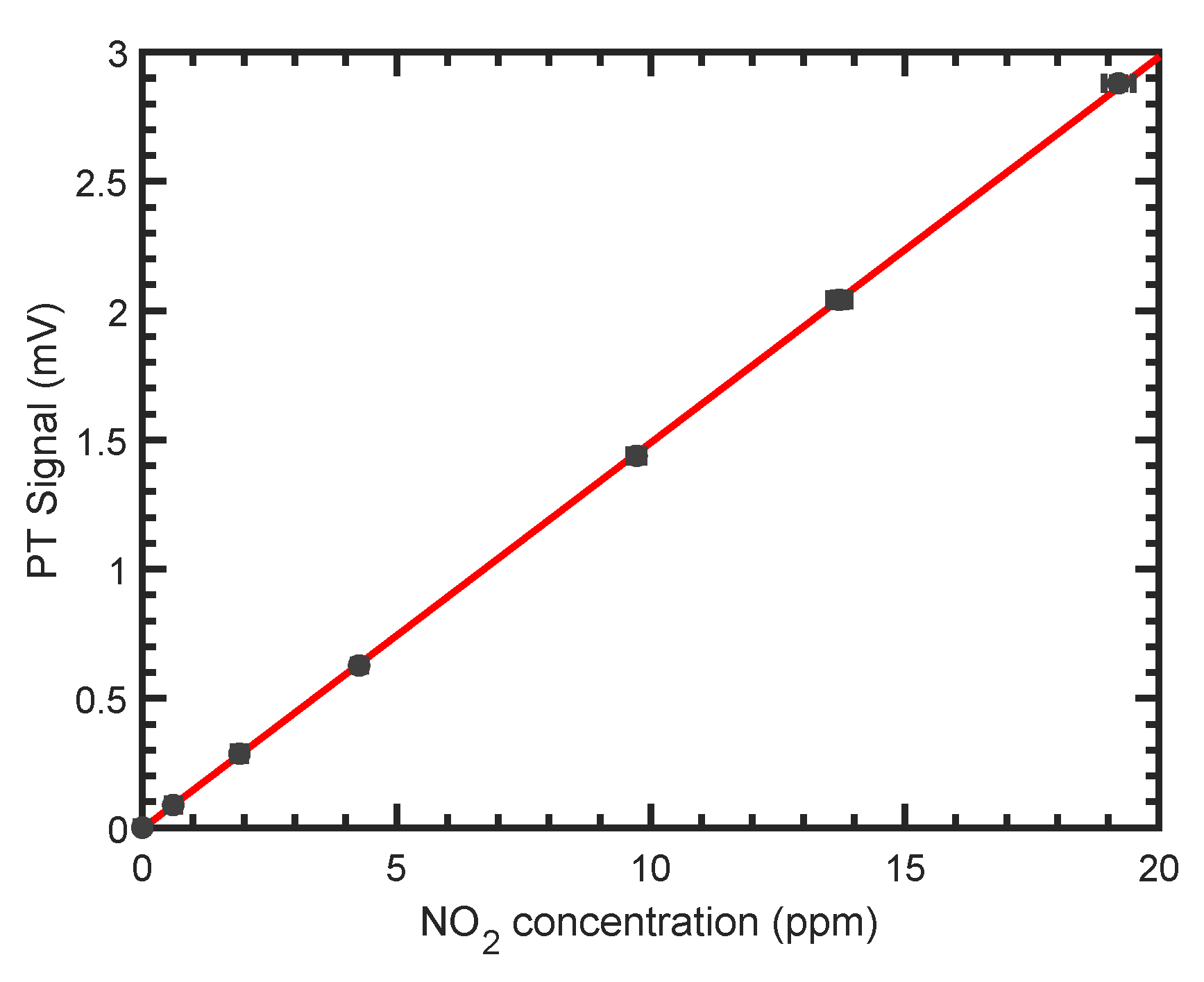
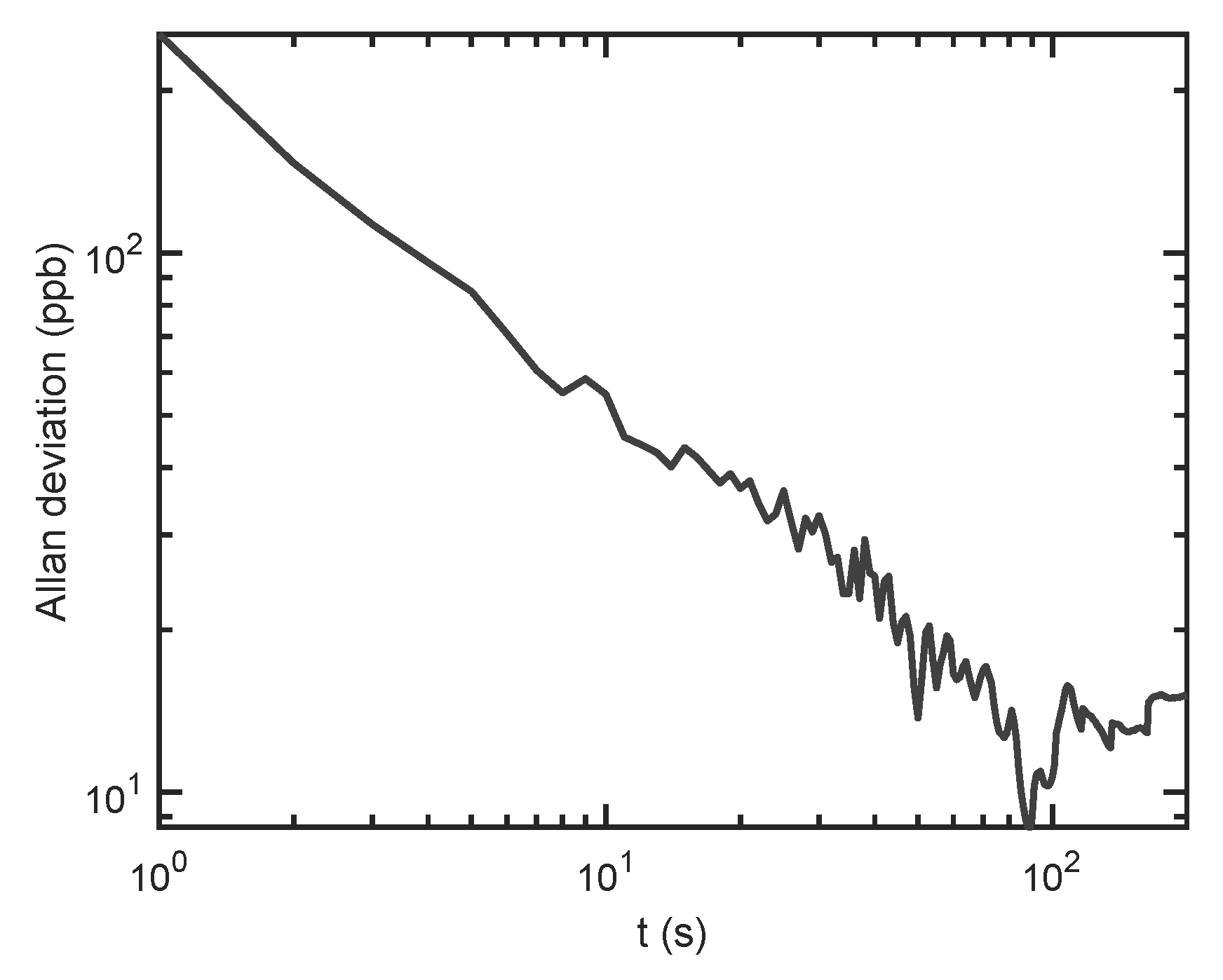

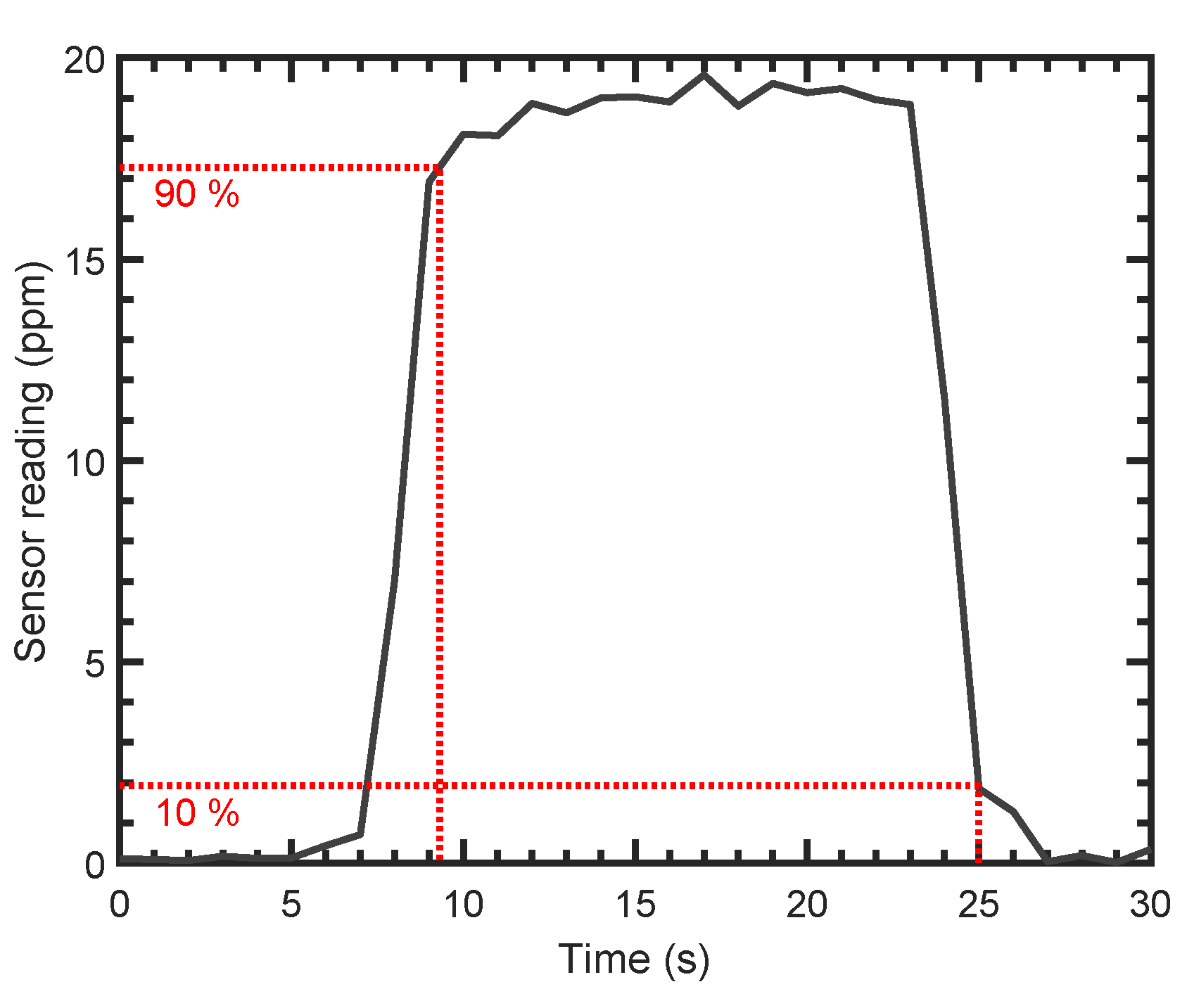
© 2019 by the authors. Licensee MDPI, Basel, Switzerland. This article is an open access article distributed under the terms and conditions of the Creative Commons Attribution (CC BY) license (http://creativecommons.org/licenses/by/4.0/).
Share and Cite
Breitegger, P.; Lang, B.; Bergmann, A. Intensity Modulated Photothermal Measurements of NO2 with a Compact Fiber-Coupled Fabry–Pérot Interferometer. Sensors 2019, 19, 3341. https://doi.org/10.3390/s19153341
Breitegger P, Lang B, Bergmann A. Intensity Modulated Photothermal Measurements of NO2 with a Compact Fiber-Coupled Fabry–Pérot Interferometer. Sensors. 2019; 19(15):3341. https://doi.org/10.3390/s19153341
Chicago/Turabian StyleBreitegger, Philipp, Benjamin Lang, and Alexander Bergmann. 2019. "Intensity Modulated Photothermal Measurements of NO2 with a Compact Fiber-Coupled Fabry–Pérot Interferometer" Sensors 19, no. 15: 3341. https://doi.org/10.3390/s19153341
APA StyleBreitegger, P., Lang, B., & Bergmann, A. (2019). Intensity Modulated Photothermal Measurements of NO2 with a Compact Fiber-Coupled Fabry–Pérot Interferometer. Sensors, 19(15), 3341. https://doi.org/10.3390/s19153341




